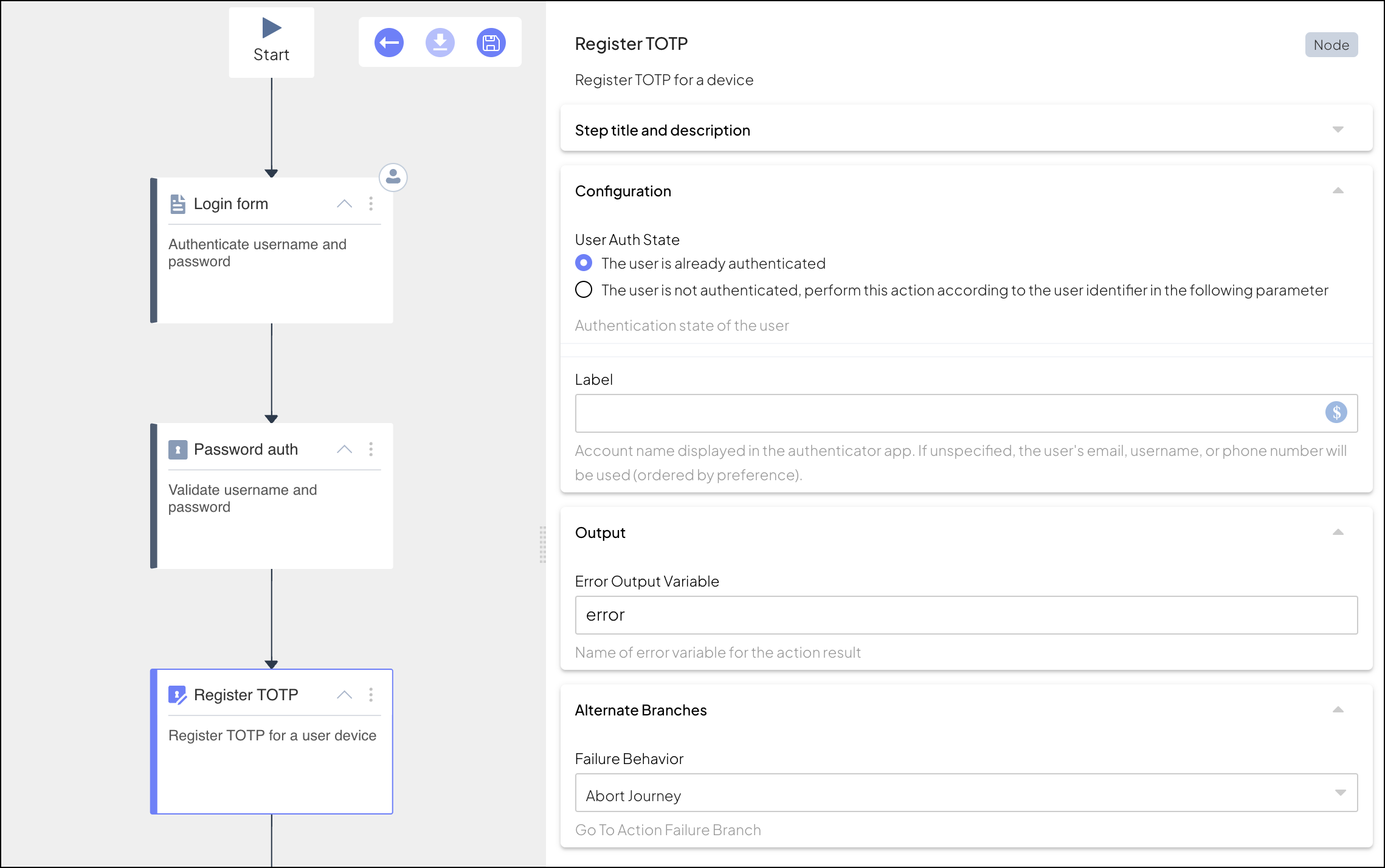Register TOTP
Registers a TOTP authenticator for the user
About client-facing steps
A journey is a sequence of steps that are executed when it's invoked by a client application (known as the "client"). Some steps require involvement from the client, such as to collect user input. Other steps, like validating a token, are executed in the backend by the Mosaic journey engine alone.
When invoked, the journey begins executing the steps while the client waits for further instructions. When a journey reaches a client-facing step, the journey asks the client for the required input and then waits for the client to respond. The client presents their own UI if user interaction is required, and returns input to the journey. The journey then proceeds in a similar manner until it's completed.
Description
This client-facing step is used to register an authenticator for TOTP authentication. TOTP is often used as a second-factor for MFA, or to step-up authentication for high-risk operations.
Time-based one-time passcodes (TOTP) codes are unique numeric codes generated based on the current time and a shared secret. Codes are generated by a mobile authenticator app (like Google Authenticator, Microsoft Authenticator, or Twilio Authy), and then validated by the authenticator using the TOTP Authentication step.
A TOTP authenticator is registered to a specific user and application. The user context for the step may be provided implicitly by the journey if the user is already authenticated; otherwise, a user identifier must be specified in the step configuration. A TOTP authenticator should only be registered to a user that has verified their identity—for example, using email OTP, document verification, or externally using a legacy identity provider.
When triggered, this step generates a static secret that will be used for generating codes, and returns it to the client (along with a URI that contains the secret and other TOTP configuration). The client is responsible for ensuring the secret gets registered in the user's authenticator app. For example, the client can embed the returned URI in a QR code and instruct the user to scan it using an authenticator app installed on their mobile device.
Once registered, the client submits an empty response to the journey to indicate that the step was completed and the journey proceeds to the next step. If this step fails, the journey proceeds to a failure branch (if specified); otherwise, the journey is aborted and an error is sent to the client.
Security features for TOTP authentication can be customized in the TOTP method settings for the application. By default, the passcode includes 6 digits and changes every 30 seconds.
Note
- A user can only register one authenticator per application.
- The authenticator is considered registered once the secret is created, even if it wasn't successfully added to an authenticator app.
- You can also integrate a custom TOTP generator into your mobile app. Learn more
Configuration
| Field | Description |
|---|---|
| User Auth State | Indicates if the user has authenticated in this journey. - If set to The user is authenticated (default), the user context is provided implicitly by the journey. - If set to The user is not authenticated, a user identifier must be provided. Note that, if the identifier doesn’t exist, a Mosaic user record is automatically created. |
| User Identifier | User identifier, specified as an expression. Only configured if the journey doesn't authenticate the user before invoking this step. |
| Label | Account name to display in the authenticator app, specified as an expression. If unspecified, the user's email, username, or phone number will be used (ordered by preference). |
| Error Output Variable | Name of the variable that stores any errors returned by step |
| Failure Behavior | Determines the behavior in case of failure, which either aborts the journey or proceeds to a failure branch of the control flow (default). |
Example
Suppose a journey registers a TOTP authenticator for a user after they log in using password:

When executed, this step returns to the client the idoServiceResponse object. It will have the journeyStepId set to TotpRegistration and the data will include the following:
{
"data": {
"payload": {
"secret": "<secret>", // Secret used to generating codes
"uri": "<uri>" // URI containing secret and other TOTP configuration
},
}
}The client shares the secret with the user, who registers it in their mobile authenticator app. For example, the client can embed the URI in a QR code for the user to scan with their mobile app. Once completed, the client send the following empty response to the journey to complete the step:
window.tsPlatform.ido.submitClientResponse(
ClientResponseOptionType.ClientInput
)TSIdo.submitClientResponse(
TSIdoClientResponseOptionType.ClientInput.type,
null,
callback
)TSAuthentication.shared.registerTOTP(URI: [URI], securityType: [SECURITY_TYPE]) { result in
switch result {
case .success(let response):
debugPrint("[DEBUG]: UUID: \(response.uuid)")
debugPrint("[DEBUG]: issuer: \(response.issuer)")
debugPrint("[DEBUG]: label: \(response.label)")
case .failure(let error):
switch error {
case .totpError(let error):
debugPrint("[DEBUG]: \(error.message)")
// Handle TOTP error
default:
debugPrint("[DEBUG]: \(error.message)")
// Handle other SDK errors
}
}
}